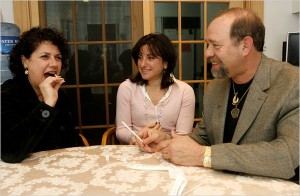 New York – For years, Allen Rosenberg, a real estate developer from Hewlett Bay Park, has had a nagging thought: What if a first or second cousin survived the Holocaust and he didn’t know it?
New York – For years, Allen Rosenberg, a real estate developer from Hewlett Bay Park, has had a nagging thought: What if a first or second cousin survived the Holocaust and he didn’t know it?
Subscribe to our Daily Roundup Email
“Maybe my cousin was placed in a displaced person’s camp on the other side of Germany or in Poland,” said Mr. Rosenberg, who is 45.
As far as he knows, Mr. Rosenberg said, his father, who went into a hospital in Hamburg, Germany, with tuberculosis right after World War II and died in 1988, was the only member of his family to survive the Holocaust. Still, he said, “there is that slim chance.”
Until recently, Mr. Rosenberg could do no more than wonder. Then he learned of the DNA Shoah Project, which seeks to reunite families torn apart by the Holocaust. Shoah is the Hebrew word for Holocaust.
The nonprofit project is asking survivors, their children and grandchildren to provide a DNA sample to help build a genetic database of Jewish Holocaust survivors and their immediate descendants. The database may eventually be made available to European forensic experts attempting to identify remains of Holocaust victims.
More than 500,000 Jewish Holocaust survivors are believed to be alive, according to the Conference on Jewish Material Claims Against Germany, an organization founded in 1951 to negotiate reparations for the Holocaust.
Syd Mandelbaum of Cedarhurst, a co-founder of the project, is looking for any trace of his grandfather Shlomo Barber, who was 42 in 1942 when he disappeared while a slave laborer in Germany. Mr. Mandelbaum said his three other grandparents were murdered at Auschwitz.
Mr. Mandelbaum said that about 1,000 DNA samples had been collected since the project, which is free to participants, began three years ago. Lynn K. Davis, the project’s information specialist, said about 10,000 samples are needed for the database to be statistically significant.
“Once you get close to 10,000, you start getting hits,” she said.
Ms. Davis said the DNA samples are taken using two cotton brushes to scrape the inside of a participant’s cheeks for 30 seconds. Kits may be requested at dnashoah.org or by calling (866) 897-1150.
Mr. Mandelbaum has a long background with DNA research and with Holocaust survivors. In 1981 he helped found the first project to videotape the stories of Holocaust survivors and camp liberators. He is also a scientist with a background in genetic and DNA research who headed the American team that in the 1990s used DNA sequencing to disprove Anna Anderson’s claim that she was Anatasia, the youngest daughter of Czar Nicholas II of Russia.
After sets of nearly three dozen remains of what may have been Holocaust victims were found in Germany in 2005, Mr. Mandelbaum said, he learned that no DNA database of Holocaust victims existed. With the help of Michael Hammer, the head of a genetics analysis lab at the University of Arizona, the DNA Shoah Project was born.
Charles Srebnik, 75, of New City in Rockland County, said he was told that only he and his mother survived the Holocaust out of 300 family members in Europe. He has longed to find another relative.
“For 42 years I traveled the world, and whenever I checked into a hotel, the first thing I did was go to the local phone book and look for my families’ names,” said Mr. Srebnik, whose mother’s maiden name was Sluszny. “But I never found anything.”
“Now that they are starting to find mass graves, it’s possible my DNA might match someone,” he said.
Ann Miller of Commack said she recently learned of the project and plans to add her DNA to the database. Her grandmother died while giving birth to her mother in a concentration camp in Ukraine in 1944.
“I don’t know if my grandmother had any brothers or sisters — I know nothing about her family, not even her last name,” she said.
Joseph Fishoff, associate rabbi of Temple Beth El in Cedarhurst, said he provided his DNA because although his uncle “told me everybody is gone, I’d be thrilled to find others.”

we found a missing aunt’s daughter (the aunt was shoyn nisht du) after almost 60 years!
shouldn’t we all contribute by testing? 1,000 tests is nothing. if everyone responds (or just one member from each family) we can bring it up to 10,000 easily
There are many uses, both good and bad, that can be made of such a database. Besides connecting Holocaust survivors, the thousands of missing Yemenite children that disappeared in Israel may be connected to their original families this way. Adopted children can be connected with their families without the authorities being involved. Like all modern technology, along with the good, you may be opening a Pandora’s Box.
i never knew my parents i exidently was taken back from gojim tha hid me till the war was over .i wish i could find just one relative idon’t even know if i have had sisters or brother